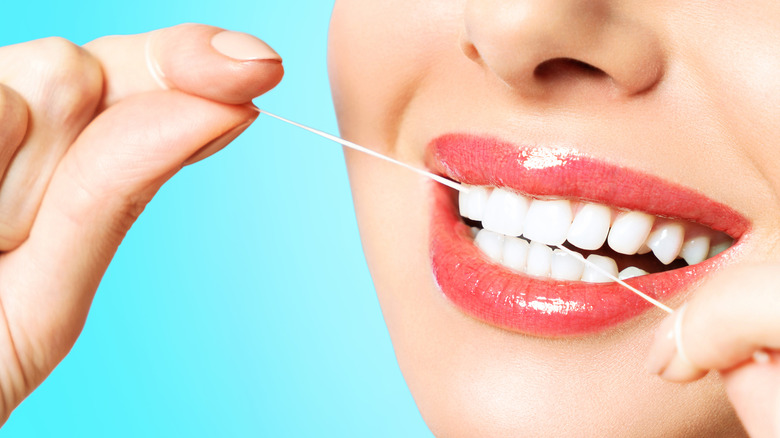This Is What Happens When You Floss Too Much
While there is no such thing as flossing too much if you're flossing the right way, flossing incorrectly can potentially harm your oral health and dental hygiene. In fact, flossing too hard can actually cause damage to your gums and teeth (via Severance Dental).
If you floss too aggressively multiple times a day, you can end up cutting into your gum tissue, causing your gums to bleed and become inflamed. Pulling the floss too far below your gum line can also result in a condition known as gum recession. Gum recession occurs when your gums recede or pull away from your teeth, exposing the roots of your teeth.
This is often caused by pulling too hard on the floss, which can cause the string to aggressively pull on your gum tissue and injure it in the process. If bacteria enters the wounds in your gums, you can potentially develop an infection. Furthermore, flossing too vigorously and applying too much pressure on your gums and at the base of your teeth can even wear away at the enamel on your teeth. In some cases, this can lead to gum disease and tooth sensitivity. To yield the best results, try to be gentle on your gums and limit your flossing to no more than two times per day.
How to floss correctly
Flossing is an essential part of dental hygiene. It can remove plaque and bacteria from your teeth and help prevent cavities from forming. That's why it's important to learn how to floss the right way (via Women's Health). To floss correctly, take an 18-inch piece of floss and wrap the ends around both of your middle fingers, leaving around two inches of floss available in the middle.
Once this is done, you can use your thumbs and index fingers to navigate the floss between your teeth, using a clean section of floss for each tooth. As you do this, make sure to curve the floss up, so it brushes against the sides of your teeth. This will help remove most of the bacteria and plaque stuck between your teeth.
It's also important to floss your back teeth, although these may be a little harder to reach than the ones closer to the front of your mouth. "If using string floss for these areas is tricky for you, try the loop method," Dr. Helen Mo, a dentist in the San Francisco Bay area, told Women's Health. "Take a piece of floss, make a loop the size of your hand, and double knot to secure it. Place all your fingers except the thumb in the circle, then use your index fingers to guide the floss between the teeth. The looped circle helps the floss stay fixed instead of using a long piece of string."


